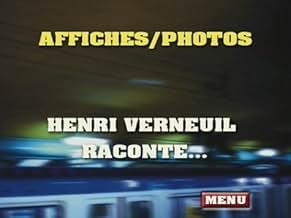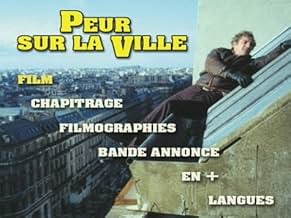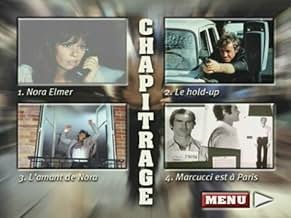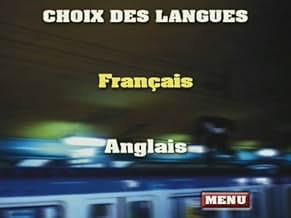CALIFICACIÓN DE IMDb
6.9/10
4.7 k
TU CALIFICACIÓN
El comisario Letellier y el inspector Moissac están rastreando a Minos, un asesino en serie cuyas víctimas son mujeres.El comisario Letellier y el inspector Moissac están rastreando a Minos, un asesino en serie cuyas víctimas son mujeres.El comisario Letellier y el inspector Moissac están rastreando a Minos, un asesino en serie cuyas víctimas son mujeres.
- Dirección
- Guionistas
- Elenco
Adalberto Maria Merli
- Pierre Valdeck
- (as Adalberto-Maria Merli)
- …
Opiniones destacadas
Skip through the special features on the DVD of Peter Yates Bullitt (1968) and you'll find an interesting featurette entitled Steve McQueen's Commitment to Reality; a promo made at the time of the film's production. As this quaint little curio unravels, we're told that McQueen had driven the iconic Ford Mustang for real, during the seminal car chases. The viewer is given the impression that the film's star is really something special for doing so. FACT: Next to French superstar Jean-Paul Belmondo's stunt work in Peur Sur La Ville, McQueen was merely dipping his little toe in a very deep pool! Reality indeed!
The action sequences in Peur Sur La Ville are nothing short of jaw dropping, even by the standards of movies today. One chase sequence in particular has Belmondo pursuing a suspect up an interior stairwell, out through a window, across a series of rooftops whilst hanging onto various fascias and bits of guttering. Smashing through a skylight, he falls into a department store. Once again on street level, a car-chase ensues, climaxing with Belmondo running atop a moving train! Verneuil lets his audience know that it's his leading man putting his neck on the line. Belmondo is clearly seen, every step of the way. This is undoubtedly one of the best examples of its kind ever committed to celluloid.
Peur Sur La Ville would probably never have been conceived if it hadn't been for the aforementioned Bullitt or for that matter, William Friedkin's The French Connection (1971).For years, European critics sneered at American remakes/reworkings of classic foreign language films and held theirs heads high with the view that continental cinema was not only innovative, but actually set the trends for the Yanks to replicate. However, Bullitt, French Connection and Don Siegel's Dirty Harry (1971) set the record straight once and for all; the anti-hero cop was as American as the hamburger. These groundbreaking films introduced audiences to unorthodox cops that had a case to break, by any means necessary. Sometimes these cops would act as ruthless as the criminals they were fighting to keep off the streets. All three films upped the ante in terms of action and break-neck editing.
By the mid seventies, Italian directors such as Enzo G. Castellari (High Crime), Franco Martinelli (Violent Rome/Roma Violenta) Fernando De Leo (Calibre 9/Milano Calibre) and Umberto Lenzi (The Tough Ones/Italia a Mano Armata) were all dabbling with this new found genre. Whereas their American counterparts had cast the likes of Clint Eastwood, Charles Bronson and Gene Hackman, the Italians were making stars out of Franco Nero, Tomas Milian, Maurizio Merli and Fabio Testi. Although immensely enjoyable almost all of these Italian poliziers never rose above formulaic. However, Verneuil, a Turkish film-maker working in France managed to pull off a real coup with Peur Sur La Ville. By making his film a hybrid of both polizier and giallo, it works on both levels and gives it the substance lacking from the Italian pictures.
A diabolical killer calling himself Minos, is on the loose in Paris. Having lived through the `free love' of the sixties and not getting any, he decides that he will `act as an arm of justice that will condemn without pity and execute all those who wallow in the sexual mud that is drowning us.' After establishing his motive, he sets about murdering promiscuous females. Hot on his heels is police Inspector Latelier (Belmondo). Minos taunts Latelier by sending a piece of his picture after each murder, in the view that the photograph will be complete when his work is done.
As Paris' most unorthodox detective, Latelier gets sadistic pleasure from seeing his suspects squirming. During one of the Sub-plots, Latelier refuses to call a critically wounded drug dealer an ambulance until he gets the information he is after, which echoes Eastwood's Callaghan in Dirty Harry.
As much as Verneuil was influenced by the like of Siegel and Freidkin, Peur sur La Ville owes a huge debt to the films of Mario Bava. The opening scene in which Minos taunts a victim on the phone, is reminiscent of The Telephone episode of Bava's anthology Black Sabbath (1963).Later during the aforementioned chase sequence, after crashing through the skylight, Latelier and Minos face off amongst the mannequins of a poorly lit store room; a nod to the Italian maestro's Hatchet for the Honeymoon (1969).
Peur Sur La Ville features a wonderful music score by none other than Ennio Morricone. The score is integral to some of the set pieces as one would expect. During the tense opening, Morricone orchestrates only a single drumbeat. This is extremely unnerving, as we the audience, know that Minos is about to knock at the door!
Canal + Video's DVD is presented anamorphically, in its original widescreen ratio of 1:66:1. This is as good a transfer as one could expect from a film of this age. Print damage is minimal but the colours seem a little washed-out. The sound is presented in two-channel mono, but is well balanced and serves Morricone's score well. The viewer has the choice of watching the film either in the original French language or in a dubbed English version. There are no subtitles available. Extra features are limited to the original theatrical trailer (in French), an interview with Verneuil (again in French) and a poster gallery.
Peur Sur La Ville is one of the lost landmarks of action cinema but is also so much more. If you have a thing for poliziers or giallos, this ones for you!
The action sequences in Peur Sur La Ville are nothing short of jaw dropping, even by the standards of movies today. One chase sequence in particular has Belmondo pursuing a suspect up an interior stairwell, out through a window, across a series of rooftops whilst hanging onto various fascias and bits of guttering. Smashing through a skylight, he falls into a department store. Once again on street level, a car-chase ensues, climaxing with Belmondo running atop a moving train! Verneuil lets his audience know that it's his leading man putting his neck on the line. Belmondo is clearly seen, every step of the way. This is undoubtedly one of the best examples of its kind ever committed to celluloid.
Peur Sur La Ville would probably never have been conceived if it hadn't been for the aforementioned Bullitt or for that matter, William Friedkin's The French Connection (1971).For years, European critics sneered at American remakes/reworkings of classic foreign language films and held theirs heads high with the view that continental cinema was not only innovative, but actually set the trends for the Yanks to replicate. However, Bullitt, French Connection and Don Siegel's Dirty Harry (1971) set the record straight once and for all; the anti-hero cop was as American as the hamburger. These groundbreaking films introduced audiences to unorthodox cops that had a case to break, by any means necessary. Sometimes these cops would act as ruthless as the criminals they were fighting to keep off the streets. All three films upped the ante in terms of action and break-neck editing.
By the mid seventies, Italian directors such as Enzo G. Castellari (High Crime), Franco Martinelli (Violent Rome/Roma Violenta) Fernando De Leo (Calibre 9/Milano Calibre) and Umberto Lenzi (The Tough Ones/Italia a Mano Armata) were all dabbling with this new found genre. Whereas their American counterparts had cast the likes of Clint Eastwood, Charles Bronson and Gene Hackman, the Italians were making stars out of Franco Nero, Tomas Milian, Maurizio Merli and Fabio Testi. Although immensely enjoyable almost all of these Italian poliziers never rose above formulaic. However, Verneuil, a Turkish film-maker working in France managed to pull off a real coup with Peur Sur La Ville. By making his film a hybrid of both polizier and giallo, it works on both levels and gives it the substance lacking from the Italian pictures.
A diabolical killer calling himself Minos, is on the loose in Paris. Having lived through the `free love' of the sixties and not getting any, he decides that he will `act as an arm of justice that will condemn without pity and execute all those who wallow in the sexual mud that is drowning us.' After establishing his motive, he sets about murdering promiscuous females. Hot on his heels is police Inspector Latelier (Belmondo). Minos taunts Latelier by sending a piece of his picture after each murder, in the view that the photograph will be complete when his work is done.
As Paris' most unorthodox detective, Latelier gets sadistic pleasure from seeing his suspects squirming. During one of the Sub-plots, Latelier refuses to call a critically wounded drug dealer an ambulance until he gets the information he is after, which echoes Eastwood's Callaghan in Dirty Harry.
As much as Verneuil was influenced by the like of Siegel and Freidkin, Peur sur La Ville owes a huge debt to the films of Mario Bava. The opening scene in which Minos taunts a victim on the phone, is reminiscent of The Telephone episode of Bava's anthology Black Sabbath (1963).Later during the aforementioned chase sequence, after crashing through the skylight, Latelier and Minos face off amongst the mannequins of a poorly lit store room; a nod to the Italian maestro's Hatchet for the Honeymoon (1969).
Peur Sur La Ville features a wonderful music score by none other than Ennio Morricone. The score is integral to some of the set pieces as one would expect. During the tense opening, Morricone orchestrates only a single drumbeat. This is extremely unnerving, as we the audience, know that Minos is about to knock at the door!
Canal + Video's DVD is presented anamorphically, in its original widescreen ratio of 1:66:1. This is as good a transfer as one could expect from a film of this age. Print damage is minimal but the colours seem a little washed-out. The sound is presented in two-channel mono, but is well balanced and serves Morricone's score well. The viewer has the choice of watching the film either in the original French language or in a dubbed English version. There are no subtitles available. Extra features are limited to the original theatrical trailer (in French), an interview with Verneuil (again in French) and a poster gallery.
Peur Sur La Ville is one of the lost landmarks of action cinema but is also so much more. If you have a thing for poliziers or giallos, this ones for you!
"Peur Sur La Ville" (aka. "Fear Over The City"/"The Night Caller") of 1975 is a great and excellently made French Thriller with the great Jean-Paul Belmondo in the lead. While this film was clearly inspired by American cult flicks, such as "Dirty Harry", "Bullit" or the "French Connection", and furthermore took its influence in early 70s Italian Gialli and Poliziotteschi, it remains very French and quite original. The story may not be the most original ever, but the way it is executed, the brilliant photography and director Henry Verneuil's great sense for stylistic tricks give this an immense originality. Commisaire Jean Lettelier played by Belmondo is the French equivalent to Clint Eastwood's Dirty Harry and the tough coppers of Italian cinema played by actors like Maurizio Merli and Henry Silva. While the cop played by Bebel is an unorthodox tough guy like his American and Italian counterparts, he is also a typically French macho, talkative, chain-smoking and always wearing elegant clothes. This is a a French/Italian co-production, and while its characters and mood are very French, it uses many elements of contemporary Italian genre-cinema.
Comissaire Jean Lettelier (Belmondo) is a tough Paris cop, who is in desperate search for a gangster named Marnucci, who has once shot a civilian while escaping from Letellier after a bank robbery. But Lettelier has little time to focus on the gangster he is after. A psychopathic killer who calls himself Minos terrorizes the French capital, murdering women whom he considers morally reprehensible... The film delivers the popular 'tough cop vs. murderous psycho' formula in an excellent and visually stunning manner. Both the action- and the suspense-sequences are photographed brilliantly, in supreme camera angles and using great visual gimmicks (I won't spoil anything by giving examples). The performances are great. I'm a Belmondo-fan in general, and the role of the the rough-and-ready copper fits Bebel like a glove. Charles Denner makes a very good sidekick as Inspector Moissac, and the rest of the performances are also very good, especially Adalberto Maria Merli. With 120 minutes, the film is quite long for a cop-thriller, but it never seems long. Since the film is brilliantly shot, full of action and maintains the suspense from the beginning to the end, these two hours go by very quickly. Apart from great suspense and action, a brilliant visual style, and a great leading performance and supporting cast, the film profits from an ingenious score. All things considered "Peur Sur La Ville" is a tantalizing and great Thriller that no fan of 70s cinema should miss. Highly recommended!
Comissaire Jean Lettelier (Belmondo) is a tough Paris cop, who is in desperate search for a gangster named Marnucci, who has once shot a civilian while escaping from Letellier after a bank robbery. But Lettelier has little time to focus on the gangster he is after. A psychopathic killer who calls himself Minos terrorizes the French capital, murdering women whom he considers morally reprehensible... The film delivers the popular 'tough cop vs. murderous psycho' formula in an excellent and visually stunning manner. Both the action- and the suspense-sequences are photographed brilliantly, in supreme camera angles and using great visual gimmicks (I won't spoil anything by giving examples). The performances are great. I'm a Belmondo-fan in general, and the role of the the rough-and-ready copper fits Bebel like a glove. Charles Denner makes a very good sidekick as Inspector Moissac, and the rest of the performances are also very good, especially Adalberto Maria Merli. With 120 minutes, the film is quite long for a cop-thriller, but it never seems long. Since the film is brilliantly shot, full of action and maintains the suspense from the beginning to the end, these two hours go by very quickly. Apart from great suspense and action, a brilliant visual style, and a great leading performance and supporting cast, the film profits from an ingenious score. All things considered "Peur Sur La Ville" is a tantalizing and great Thriller that no fan of 70s cinema should miss. Highly recommended!
What we have here is a crime thriller that includes most of the clichés of the genre, but does it in such a way that it feels original due to the execution. Henri Verneuil's film is really not what I was expecting it to be at all; it's actually a lot more than just a film about cops hunting a vicious psychopath and while not everything about the film works, what does work works brilliantly and this is certainly among the best European crime thrillers of the 1970's. The film is a French and Italian co-production, and while it's clear that the film is much more French than Italian; we still get some trademarks of Italian cinema thrown in and the film has elements of both the Polizi and Giallo genres. The plot simply focuses on an unknown serial killer that targets loose women in Paris by way of phone calls and later murder. Commissioner Jean Letellier and Inspector Moissac are put on the case and have to go through the Parisian underworld before coming close to catching the killer and discovering his insane reason for murdering the women of Paris.
The thing that really makes this film stand out is the leading performances courtesy of Jean-Paul Belmondo and Charles Denner. The pair fit into their roles excellently individually and have a great chemistry also, which director Henri Verneuil is keen to exploit as much as possible as the two actors provide the film with most of its best moments and also deliver some comedy. The film is not overly gory and the focus is never on the murders; although there are a few featured and the way that the director focuses on the killer's black gloves is a nice nod towards Giallo. The film features many of the crime film staples such as car chases and shootouts; a sequence that sees the main protagonist chase the killer in the middle of the film is excellently staged and very thrilling. The film changes pace many times throughout but the director always manages to keep things interesting. Adalberto Maria Merli's portrayal of the villain is suitably demented and detestable and the way that the film boils down towards the conclusion is well done and completely unexpected. Overall, this is an excellent film that doesn't deserve to be forgotten about and therefore comes highly recommended!
The thing that really makes this film stand out is the leading performances courtesy of Jean-Paul Belmondo and Charles Denner. The pair fit into their roles excellently individually and have a great chemistry also, which director Henri Verneuil is keen to exploit as much as possible as the two actors provide the film with most of its best moments and also deliver some comedy. The film is not overly gory and the focus is never on the murders; although there are a few featured and the way that the director focuses on the killer's black gloves is a nice nod towards Giallo. The film features many of the crime film staples such as car chases and shootouts; a sequence that sees the main protagonist chase the killer in the middle of the film is excellently staged and very thrilling. The film changes pace many times throughout but the director always manages to keep things interesting. Adalberto Maria Merli's portrayal of the villain is suitably demented and detestable and the way that the film boils down towards the conclusion is well done and completely unexpected. Overall, this is an excellent film that doesn't deserve to be forgotten about and therefore comes highly recommended!
A nice polar movie that makes us follow the murders committed by a serial killer and, first and foremost, of a "no-brain-all-muscles" cop, played by Belmondo.
As this is a French movie, of course, the cop is not just plain (nor Eastwood style, nor Willis style) and comes with comedy and some parody.
But we do have a good set of action scenes, with a memorable one on the roofs of Paris.
The score, chiseled as all other Ennio Morricone's work, is the finishing touch that involves us in the ride!
The score, chiseled as all other Ennio Morricone's work, is the finishing touch that involves us in the ride!
Oh, how I love the raw and gritty 70's action cinema! Most of it was all about rude and extremely unorthodox macho police detectives hunting down utterly deranged psychopaths that leave a trail of terror and bloodshed throughout the most major cities of our world. The US delivered a couple of brilliant milestones in the genre (like "Dirty Harry" and "The French Connection"), Italy is probably world record holder with all their masterful "Poliziotteschi" classics, and also France proudly owns a handful of goodies. Henri Verneuil's "Peur sur la Ville" is a prototypic 70's cop thriller, and this definition basically translates into: high adrenalin action from start to finish, straightforward but tense plot lines, cool cops, nightmarish criminals, sharp dialogs, pitch-black humor and an awesome soundtrack! J-P Belmondo is absolutely terrific as the dry and sarcastic Commissioner Letellier, charged with the case of a misogynic killer who menaces his victims via the phone prior to actually strangling them. Letellier is initially quite reluctant to lead the investigation, as he's too preoccupied with catching the bank robber that killed his previous partner, but then manages to conjoin the two man hunts. The killer, who baptized himself Minos, is a delightful lunatic with one creepy-looking glass eye and a rather peculiar opinion on femininity. "Peur sur la Ville" features many recurring highlights, like the many sardonic interactions between Commissioner Letellier and his partner Moissac, but of course the most obvious aspect to worship here is the action. Belmondo literally bounces around Paris, from the rooftops of apartment buildings to all the way down in the subway network. One particular chase sequence lasts for nearly twenty minutes and includes both of Letellier's suspect targets. Making it all even more impressive is the fact that J-P Belmondo performed his own stunts. Gazing at some of the set pieces, I can assure you that he repeatedly must have risked his neck throughout this production. Nearly forty years later now, films like "Peur sur la Ville" may indeed come across as somewhat dated and overly clichéd, but it's still tremendously exhilarating and entertaining. Besides, back then those clichés weren't clichés just yet. It's just indescribably charming and fun to watch car-chases featuring those typical light European automobiles making random casualties left, right and center. The climax is tense, albeit a bit tedious and overly stretched, and you won't notice for a second that this is actually quite long for an action/thriller (+120min). Last but definitely not least, the always reliable Ennio Morricone delivers a dazzling soundtrack as well. Hearing his eerie tones during the opening credits, and you just know you're about to witness an overall excellent movie.
¿Sabías que…?
- TriviaJean-Paul Belmondo performs his own stunts. He was coached by Rémy Julienne.
- ErroresWhen Minos visits the police station in order to talk to Letellier, two healthy eyes can be seen behind his sunglasses.
- Créditos curiososBoth the RATP (the Parisian Autonomous Transit Network) and the GIGN (the Intervention Group of the National Gendarmerie) were thanked on the closing credits.
- Versiones alternativasThere are many different run times for this film. The Euro versions run the longest and the US/UK versions (known as The Night Caller)run the shortest. However "The Night Caller" contains some footage not seen in the longer running time versions. The US version runs 91 minutes while the UK version runs about a minute shorter (with some violence cut out.)
- ConexionesFeatured in Vivement dimanche: Jean-Paul Belmondo 2 (2013)
Selecciones populares
Inicia sesión para calificar y agrega a la lista de videos para obtener recomendaciones personalizadas
- How long is The Night Caller?Con tecnología de Alexa
Detalles
Taquilla
- Presupuesto
- FRF 12,000,000 (estimado)
- Tiempo de ejecución2 horas 5 minutos
- Mezcla de sonido
- Relación de aspecto
- 1.66 : 1
Contribuir a esta página
Sugiere una edición o agrega el contenido que falta

Principales brechas de datos
By what name was Peur sur la ville (1975) officially released in India in English?
Responda
![Ver Bande-annonce [OV]](https://m.media-amazon.com/images/M/MV5BNmQ2ZGNlOGUtNjk1OC00YmNhLWEyYzAtYzQzMmNjZjIzMGEzXkEyXkFqcGdeQXRodW1ibmFpbC1pbml0aWFsaXplcg@@._V1_QL75_UY281_CR1)




























